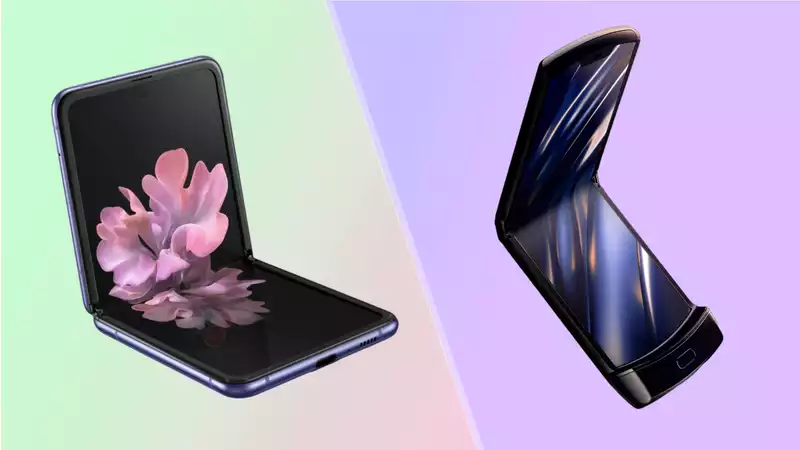Classic design is about to be reinvented before our eyes. Motorola's new Razr and Galaxy Z Flip (both available now) are the first ever foldable phones with a clamshell design that combines a retro look with cutting-edge technology. But which of these new-age flip phones will win out?
The Motorola Razr, with its 2000s iconic recognition and convenient Quick View display on the front, and the Samsung, with its lower price, larger display, and more enhanced specs, could outshine its rivals. That means at least one of these devices could definitely make our best phones list.
Here's how these two folding phones stack up so far.
The Motorola Razr costs $1,500 and hits store shelves on February 6; on February 14, the Galaxy Z Flip also launched for $1,380; it will be available on AT&T and Sprint, but in limited quantities. (Samsung is not kidding about the limited part; see Galaxy Z Flip retailers here.)
The Motorola Razr design is inspired by one of the most popular clamshell phones of all time and features a compact design when closed. Like the original, it has a chin at the bottom, but features a fingerprint sensor to quickly unlock the foldable phone.
The back is textured to make the Razr easier to grip. The entire phone measures just 3.7 x 2.83 x 0.55 inches when closed, slightly larger but thinner than the Galaxy Z Flip's 3.4 x 2.9 x 0.68 inches.
When open, the Razr and Galaxy Z Flip are evenly sized, but the Razr is heavier at 7.2 ounces, while the Z Flip weighs 6.5 ounces.
Only the Galaxy Z Flip has a Hideaway hinge that allows the phone to be opened halfway like a laptop, optimized for capturing video content and taking selfies. It also has a flex mode that splits the display into two 4-inch screens, allowing users to view content on the top side and operate on the bottom side.
The Galaxy Z Flip comes in Mirror Purple and Mirror Black, both of which change color depending on ambient light; the Razr is only available in Smokey Black, but a gold model will appear later. Currently, Samsung seems to have the upper hand in the style department.
As for the screen, there are very significant differences between the Motorola Razr and the Galaxy Z Flip. When open, the Z Flip has a large 6.7" OLED display while the Motorola Razr is only 6.2".
Additionally, the Razr has a plastic internal display, while the Z Flip has a foldable, ultra-thin glass display. According to our tests so far, this makes a huge difference in the feel of the phone.
In appearance, the Razr leads with its 2.7" Quick View display. It can respond quickly to messages with voice commands, interact with Google Assistant, and control music playback.
On the other hand, the Galaxy Z Flip's exterior panel is only 1.1 inches, so you won't see much information other than the time and notifications. However, it can at least be used as a mini viewfinder for selfies.
Motorola worked with Lenovo for four years and developed 26 prototypes before perfecting the Razr's foldable display. Thanks to two stainless steel hinges connected via sliding support plates, there is no gap when the phone is closed.
However, Motorola warns that "bumps and lumps" are normal, and we noticed a small dent in the screen during our testing. Motorola also does not provide any sort of estimate of the number of open/close cycles that can be done on the Razr, which is worrisome.
Samsung, on the other hand, has put the number of open/close cycles for the Galaxy Z Flip at over 200,000. According to Samsung, the hinge system is made of nylon fibers created with micro-height cut technology, which repels dirt and dust.
The Galaxy Z Flip is a more powerful foldable flip phone based on its specs: a Snapdragon 855 Plus processor, 8GB of RAM, and 256GB of storage. It has a mid-range Snapdragon 710 processor, 6GB of RAM, and 128GB of storage.
Now, the target audience for these foldable phones will not care as much about the technical specs compared to the design, but it seems certain that Samsung will still have the upper hand.
Notably, neither the Razr nor the Galaxy Z Flip offer 5G connectivity.
The Razr is simple when it comes to cameras, with just one 16MP rear camera with f/1.7 aperture; the Galaxy Z Flip is more advanced when it comes to photography, with two rear cameras: a 12MP main camera and a 12MP ultra-wide shooter. [On the front, the Razr has a 5MP camera for quick selfies, while the Galaxy Z Flip has a sharper 10MP camera.
The Motorola Razr's battery is 2,510mAh, which is quite small for a flagship. Also, in Tom's Guide battery tests, the Razr lasted only a little over 6 hours.
The Galaxy Z Flip's battery is 3,300mAh, which is more capacity than Motorola's phone. We tend to expect more than 4,000 mAh batteries in premium Android phones, so we'll have to see how well these devices hold up in our web-surfing battery test.
It is also worth noting that only the Galaxy Z Flip supports both wireless charging and wireless power sharing, while the Razr does not support wireless charging at all.
The first wave of folding phones essentially failed, and the Motorola Razr failed to impress in our review. Right now, the Galazy Z Flip enjoys a significant advantage over the Razr, as it offers a larger display, better specs, a larger battery, and a more advanced camera. Before we give our final verdict, enjoy our review of the Z Flip.
.









Comments